Introduction
Embarking on a journey to enhance fitness through a daily dumbbell routine can be a game-changer for many individuals. The first step towards success lies in understanding the essential equipment and preparation that set the stage for effective workouts. With the right tools, such as:
- Appropriately weighted dumbbells
- A comfortable mat
- The commitment to hydrate and stay focused
anyone can create a powerful foundation for their fitness goals. As the trend towards home workouts continues to rise, the importance of establishing a safe and motivating environment cannot be overstated. By prioritizing preparation and safety, individuals not only pave the way for personal health improvements but also inspire those around them to embrace a culture of wellness. Now is the time to take action and transform fitness aspirations into reality.
Essential Equipment and Preparation for Your Dumbbell Routine
Starting a daily dumbbell routine can transform your fitness journey, and the first step is ensuring you have the right equipment. Here’s what you’ll need:
- Dumbbells: Select a set that suits your fitness level. Beginners should consider starting with lighter weights ranging from 5-10 lbs, while those with more experience might opt for heavier options.
- Workout Mat: A quality mat enhances comfort during floor exercises and minimizes the risk of slipping.
- Water Bottle: Hydration is crucial; keep a bottle nearby to stay energized throughout your session.
- Towel: Having a towel handy is essential for wiping away sweat and maintaining a secure grip on your dumbbells.
Preparation Steps:
- Choose a Dedicated Space: Identify a quiet area that offers ample room to move freely, ensuring it is well-lit and properly ventilated. This sets a positive tone for your workout.
- Warm-Up: Always begin with a 5-10 minute warm-up to elevate your heart rate and prepare your body for action. Incorporate light cardio or dynamic stretches to get your body ready.
- Set Goals: Clearly define your fitness objectives, whether aiming for weight loss, muscle gain, or overall health improvements. Goals serve as a compass for your routine and help maintain motivation.
As we consider the importance of incorporating regular physical activity into our lives, remember the insight from The BMJ, which states that meeting minimum physical activity guidelines can prevent about 46% of deaths associated with inactivity. This strengthens the notion that even basic exercises, such as those in a daily dumbbell routine, can have a significant impact on overall health. With 42% of Americans now preferring minimal equipment for home exercises, investing in a dumbbell routine can be a practical and effective choice. Furthermore, with more than 3 million incidents stemming from sports and recreational activities in 2021, guaranteeing safety and adequate preparation in fitness routines is essential.
The growing penetration rate for the eServices Fitness market also highlights the increasing trend towards home fitness solutions, making this an opportune time for organizations to consider employee wellness programs. Additionally, examining the most active U.S. cities, such as Miami and San Francisco, can inspire HR managers to promote similar initiatives within their organizations. Now is the time to take action and prioritize your fitness!
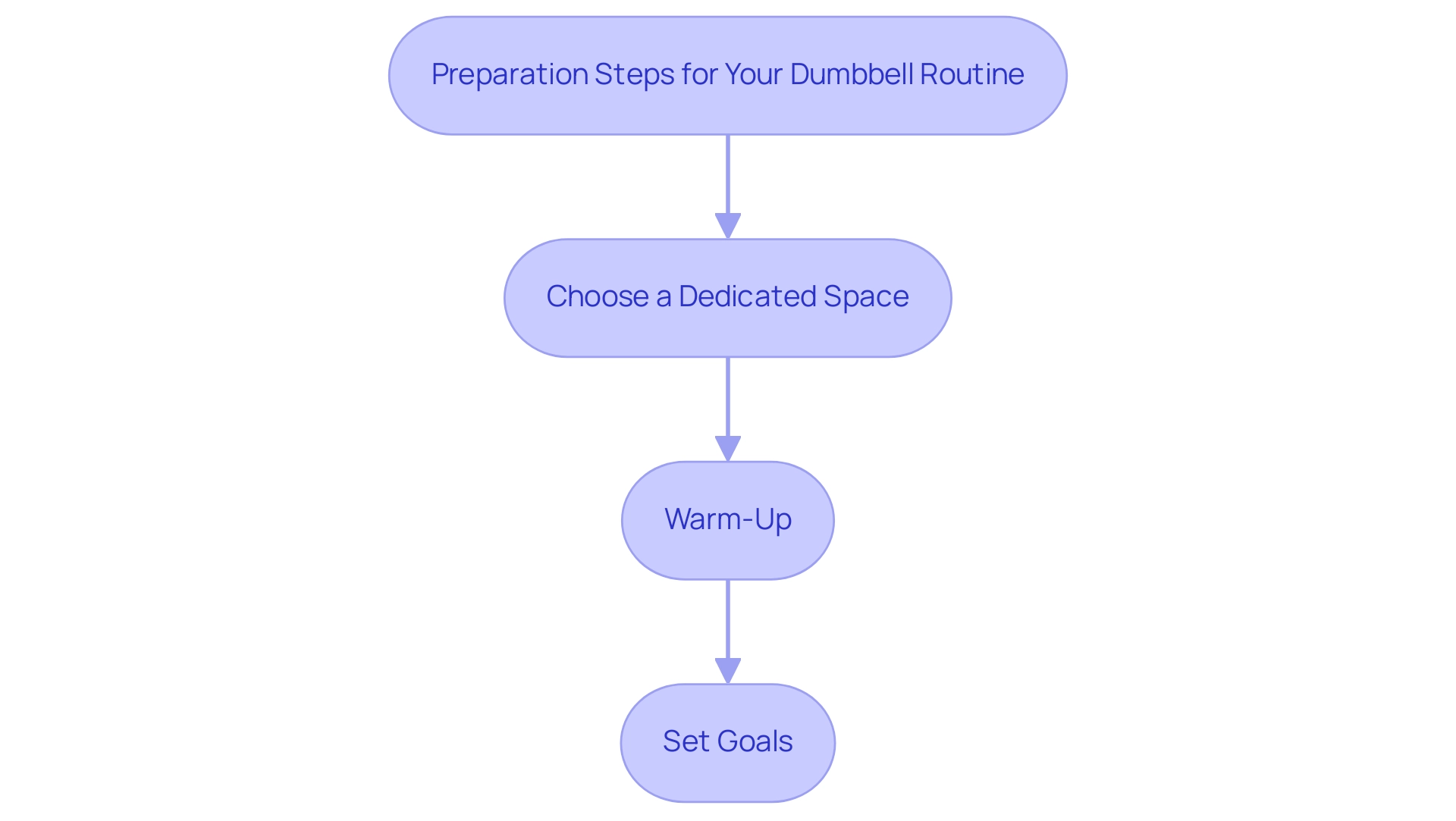
Structuring Your Daily Dumbbell Workout: Key Exercises and Techniques
A balanced daily dumbbell routine is essential for effectively targeting all major body groups, ensuring comprehensive strength development and injury prevention. Here’s a sample structure to get started:
-
Warm-Up (5-10 minutes): Begin with dynamic stretches or light cardio to prepare your body for the workout.
-
Workout Structure:
- Upper Body:
-
Dumbbell Bench Press: 3 sets of 10-12 reps. This activity effectively strengthens the pecs, shoulders, and triceps by pushing weights overhead, making it a staple in any daily dumbbell routine for upper-body strength. A case study shows that it effectively strengthens upper body muscles, enhancing overall performance.
-
Dumbbell Rows: 3 sets of 10-12 reps. As you row one dumbbell towards your rib cage, focus on keeping your elbow close to your body and squeezing your shoulder blade back, as advised by Isaac Williams, Men's Fitness editor.
Additionally, consider incorporating the Bent Over Single Arm Dumbbell Row, where you lean forward with one hand on a bench and row a dumbbell with the other hand, to further engage your back muscles.
-
- Lower Body:
- Dumbbell Squats: 3 sets of 10-15 reps. This exercise targets the quads, hamstrings, and glutes, making it vital for lower body strength.
- Lunges: 3 sets of 10-12 reps per leg. Lunges help improve balance and coordination while building leg strength.
- Core:
- Dumbbell Russian Twists: 3 sets of 15-20 reps. This move engages the obliques and enhances core stability.
- Plank with Dumbbell Row: 3 sets of 8-10 reps per side. This activity combines a plank with a row, targeting the core, back, and arms for a comprehensive workout.
- Upper Body:
-
Cool Down (5-10 minutes): Conclude with static stretches concentrating on the areas worked to aid recovery and flexibility.
Technique Tips:
- Maintain proper form to prevent injuries: Keep your back straight during lifts and engage your core throughout each movement.
- Control your movements; avoid swinging the weights to maximize the effectiveness of each activity. This method not only enhances muscle engagement but also contributes to safer training practices.
Recovery Insight: It's important to note that recovery plays a critical role in strength training. Research indicates that at 48 hours after physical activity, 40% of men have recovered following workouts to failure, highlighting the importance of allowing adequate recovery time in any workout regimen.
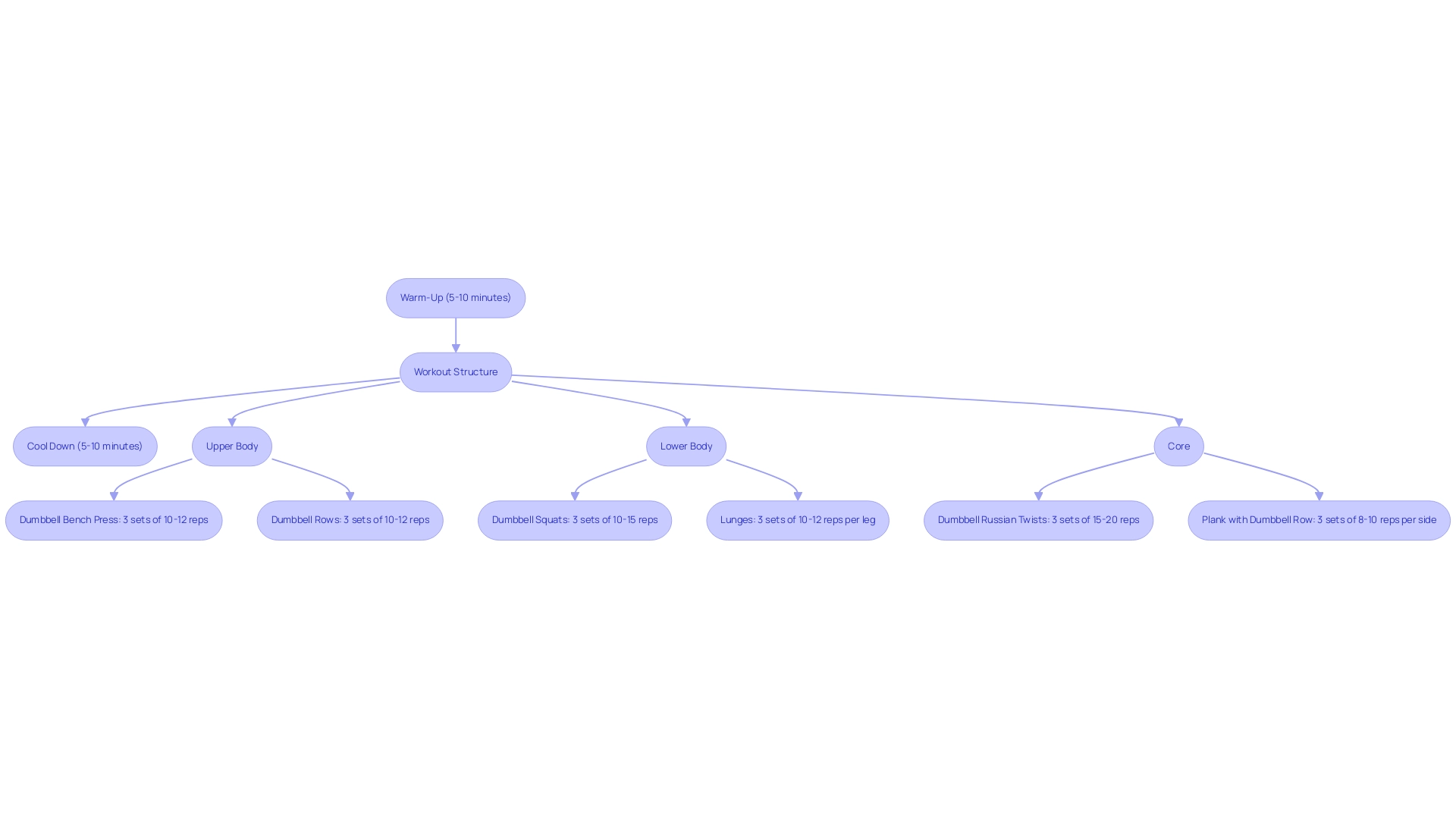
Progressing Your Dumbbell Routine: Tips for Continuous Improvement
To foster continuous improvement in your daily dumbbell routine, implement the following progression strategies:
-
Increase Weight: As your strength develops, gradually increase the weight of your dumbbells. Aiming for a 5-10% increase is effective once you can comfortably complete your sets.
Amy Kwan, a Doctor of Physical Therapy, emphasizes,You will likely make gains in strength more quickly if you are just beginning with physical activity.
This highlights the importance of making strategic adjustments early on. -
Add Reps or Sets: To enhance muscular endurance, consider increasing the number of repetitions or sets you perform for each activity.
This not only builds strength but also challenges your stamina. -
Vary Workouts: Maintain your routine interesting and captivating by including various activities focusing on the same body groups. For instance, you might substitute dumbbell shoulder presses with lateral raises, which can stimulate growth in new ways.
-
Change Tempo: Experiment with the speed of your lifts. Slowing down the eccentric (lowering) phase of each exercise increases time under tension, which is crucial for stimulating hypertrophy.
-
Track Your Progress: Keeping a training journal is invaluable.
Log your weights, repetitions, and how you feel post-exercise. This practice not only helps you identify areas for improvement but also allows you to celebrate your successes along the way, and incorporating these strategies into your daily dumbbell routine enhances your strength training and contributes to broader health benefits. Research shows that structured resistance training can lead to impressive outcomes, such as a reported strength difference of 5.0 kg (10.6% change) after systematic interventions.
Moreover, strength training has been linked to decreased mortality rates and fewer nursing home admissions among older individuals, emphasizing its importance for overall well-being. Additionally, a comprehensive review of 12 studies involving 299 subjects highlights the varying effects of resistance training on muscle hypertrophy and strength, reinforcing the effectiveness of these approaches. Embrace these tactics, and watch as you and your team progress together in strength and health.
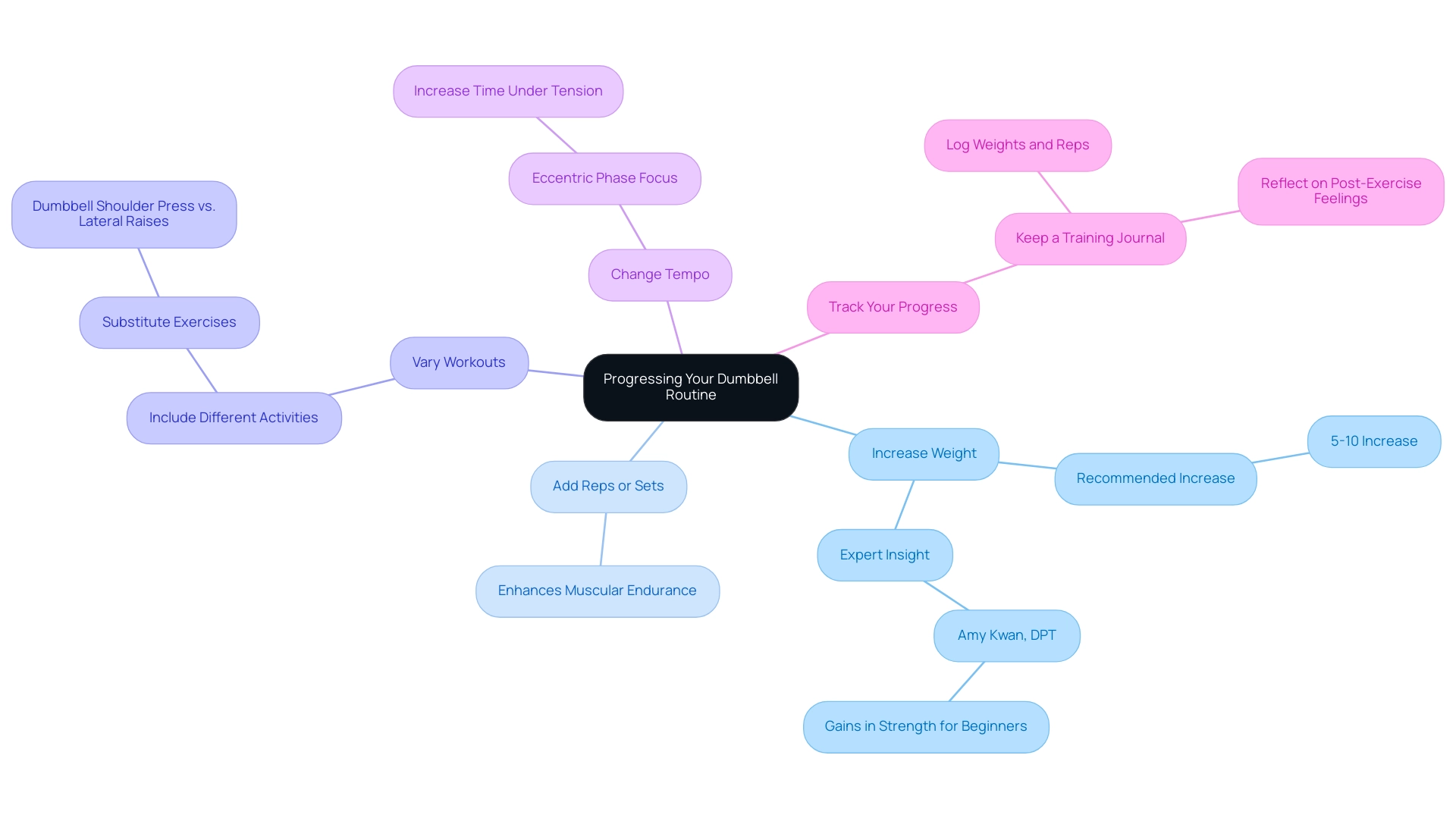
Daily Dumbbell Workouts: Safety Tips and Recovery Strategies
To ensure safety and promote effective recovery in your daily dumbbell routine, embrace these essential guidelines:
-
Listen to Your Body: Your body communicates vital information. Pay close attention to any signs of fatigue or discomfort.
If you feel pain, take a moment to assess your form or consider a rest day. This not only prevents injuries but aligns with the understanding that recognizing patterns in injuries can lead to better prevention strategies, as highlighted by expert Nwarah A. Basha.
-
Rest Days: Incorporate at least one rest day each week to allow your muscles to recover.
Engaging in active recovery activities, such as walking or yoga, can enhance your overall fitness without putting additional strain on your body. Remember, rest is as essential as the exercises themselves, as it fosters growth and resilience. This is particularly important considering that the weekly training volume of some teenage athletes rivals that of adults, making recovery even more essential for younger individuals.
-
Hydration and Nutrition: Maintain optimal hydration levels before, during, and after your exercise sessions. Proper nutrition is essential for recovery; concentrate on protein-rich foods after exercise to aid in repair. This method not only supports recovery but also readies your body for future exercises, in line with current guidelines for tissue recovery.
-
Stretching: Allocate time after each exercise session to stretch the primary groups you’ve engaged. Stretching enhances flexibility and significantly reduces muscle soreness, allowing you to maintain a consistent workout routine without setbacks.
-
Consult a Professional: If you are uncertain about your form or routine, seek guidance from a fitness professional.
This proactive measure can help you refine your technique and reduce the risk of harm, which is especially important as new reporting styles for incidents may increase reported incident rates. Furthermore, understanding the standardization of study methods in incident reporting can provide clearer insights into the safety of your training practices.
-
Consider BMI Impacts: Be aware of how body composition can affect rate of harm.
A case study examining the effect of Body Mass Index (BMI) on incident rates among weightlifters found that individuals with a normal BMI had the highest occurrence rate (13.7%). This highlights the importance of understanding personal health metrics and their relationship to injury prevention strategies in strength training, particularly when implementing a daily dumbbell routine.
By following these guidelines, you not only prioritize your safety but also empower yourself to achieve better results and foster a culture of well-being within your team.
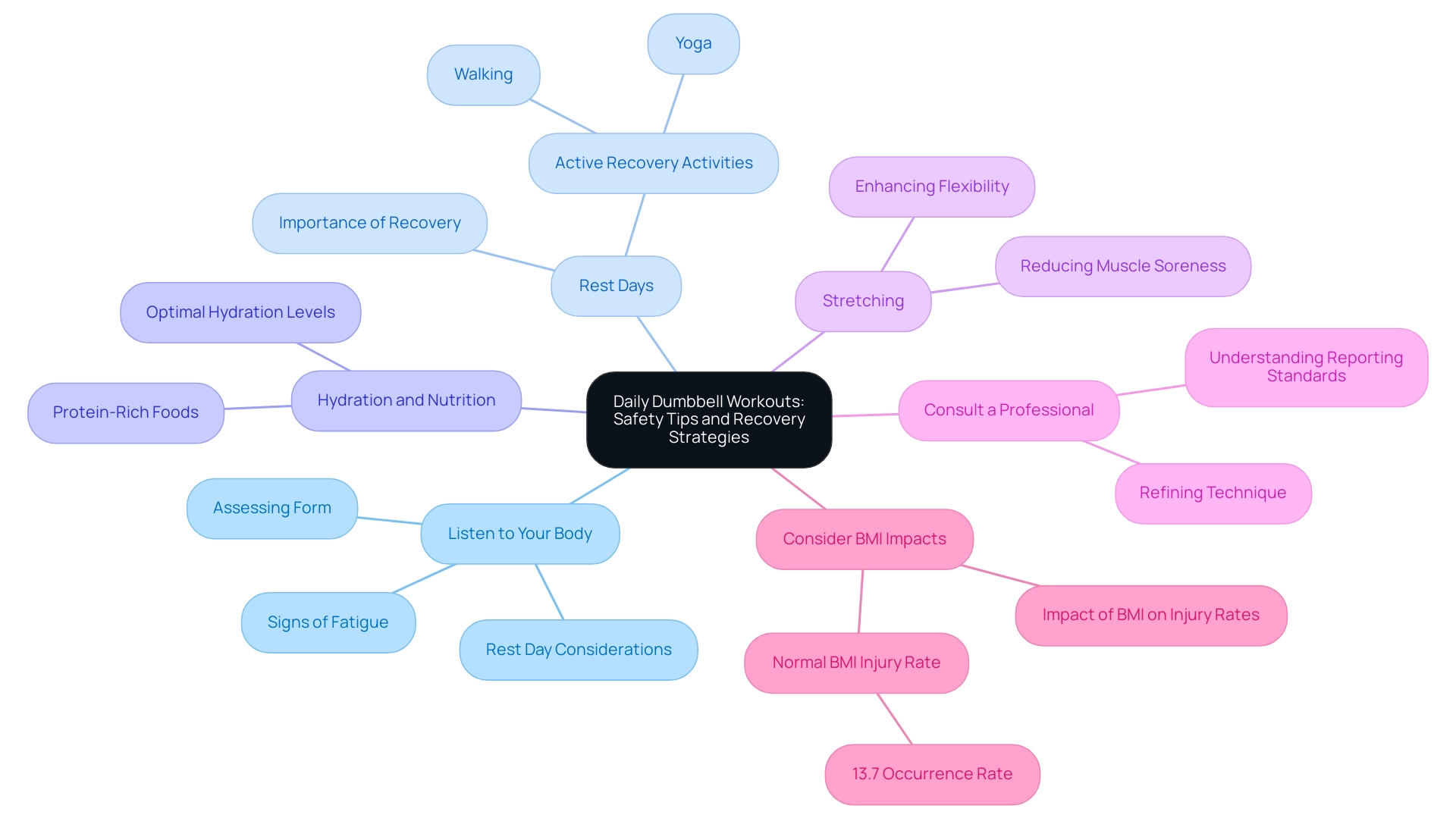
Nutrition and Wellness: Supporting Your Dumbbell Training Goals
To empower your daily dumbbell routine and optimize your performance, consider implementing these nutrition and wellness strategies:
-
Balanced Diet: Focus on a balanced diet that includes a variety of whole foods, such as lean proteins, whole grains, fruits, and vegetables. These foods provide crucial nutrients necessary for energy and recovery, establishing a solid base for your daily dumbbell routine.
According to J Sports Sci. 2011;29 Suppl 1:S29-38, a well-rounded diet is crucial for enhancing athletic performance.
-
Pre-Workout Nutrition: Fuel your body effectively by enjoying a light snack rich in carbohydrates and protein approximately 30-60 minutes before your exercise.
Think of options like a banana paired with peanut butter or a serving of Greek yogurt topped with fresh berries. However, it's important to note that, as Kulik et al. (2008) found, supplemental carbohydrate ingestion does not necessarily improve performance in high-intensity resistance exercise.
This highlights the need for a tailored approach to pre-workout nutrition.
-
Post-Workout Recovery: After completing your workout, it’s crucial to consume a meal or snack containing both protein and carbohydrates. Engaging in a daily dumbbell routine will help replenish energy stores and facilitate muscle repair.
A protein shake or a dish of chicken with quinoa and a mix of vegetables are excellent choices to aid your recovery process. Additionally, hydration plays a vital role here; as outlined in the case study on hydration needs during physical activity, maintaining proper fluid intake is essential for optimal performance and recovery.
-
Mindfulness and Stress Management: Don’t underestimate the power of a healthy mind.
Incorporate mindfulness practices, such as meditation or deep breathing techniques, to manage stress levels effectively. A calm and focused mindset is integral to achieving optimal performance and overall wellness.
-
Stay Consistent: Consistency in following a daily dumbbell routine is vital in both nutrition and exercise to reach your fitness goals.
Set realistic expectations for yourself and celebrate the small victories along the way, as they contribute to your long-term success.
These strategies not only support your physical training but also enhance your overall well-being, making it easier to achieve your fitness aspirations.
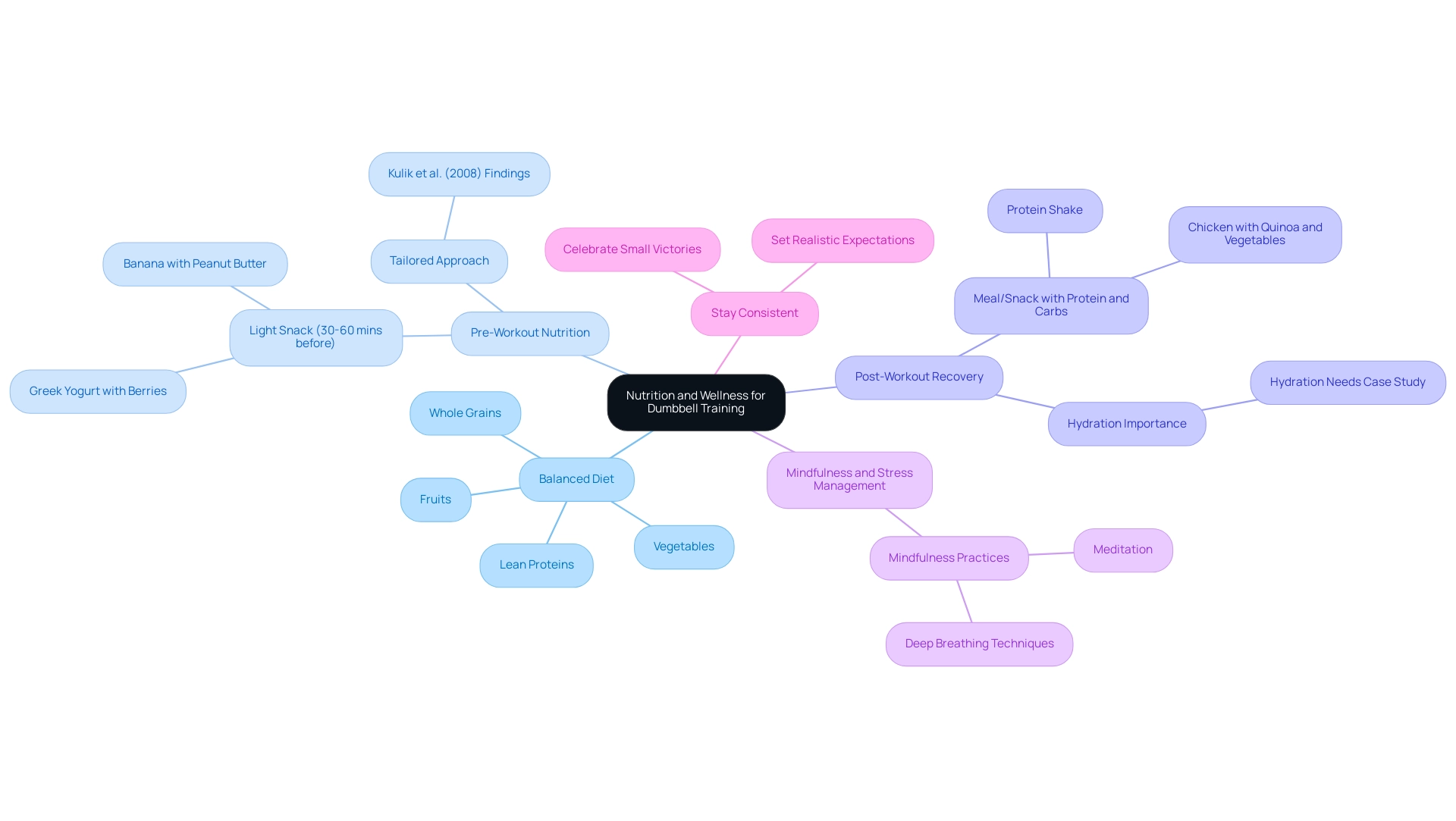
Conclusion
Creating a daily dumbbell routine is a powerful step toward enhancing personal fitness and overall well-being. By equipping oneself with the right tools and preparation, such as selecting appropriate dumbbell weights, establishing a comfortable workout space, and committing to hydration, individuals lay a strong foundation for success. This preparation not only cultivates a safe workout environment but also encourages a culture of wellness that can resonate within teams and communities.
Incorporating a structured workout that targets all major muscle groups is essential for balanced strength development and injury prevention. Through a combination of effective exercises, proper techniques, and gradual progression, individuals can witness significant improvements in their fitness levels. Emphasizing the importance of safety, recovery, and nutrition further enhances the effectiveness of any training regimen, ensuring that one remains injury-free and energized.
Ultimately, the journey to fitness is not just about physical strength; it fosters resilience, confidence, and a sense of accomplishment. By prioritizing fitness and well-being, individuals not only transform their own lives but also inspire those around them to embark on their own wellness journeys. Now is the time to take action, embrace the power of daily dumbbell workouts, and cultivate a healthier, more active lifestyle for yourself and your team.




